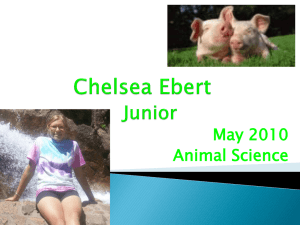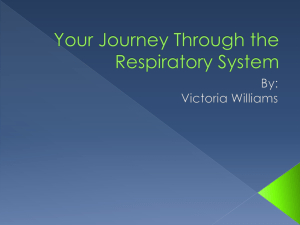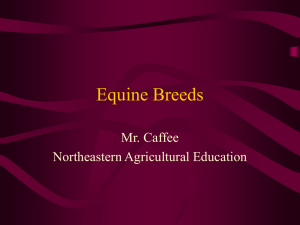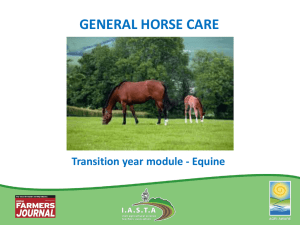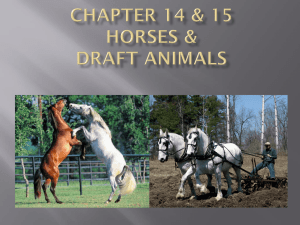Rehabilitating the Neglected Horse Article
advertisement
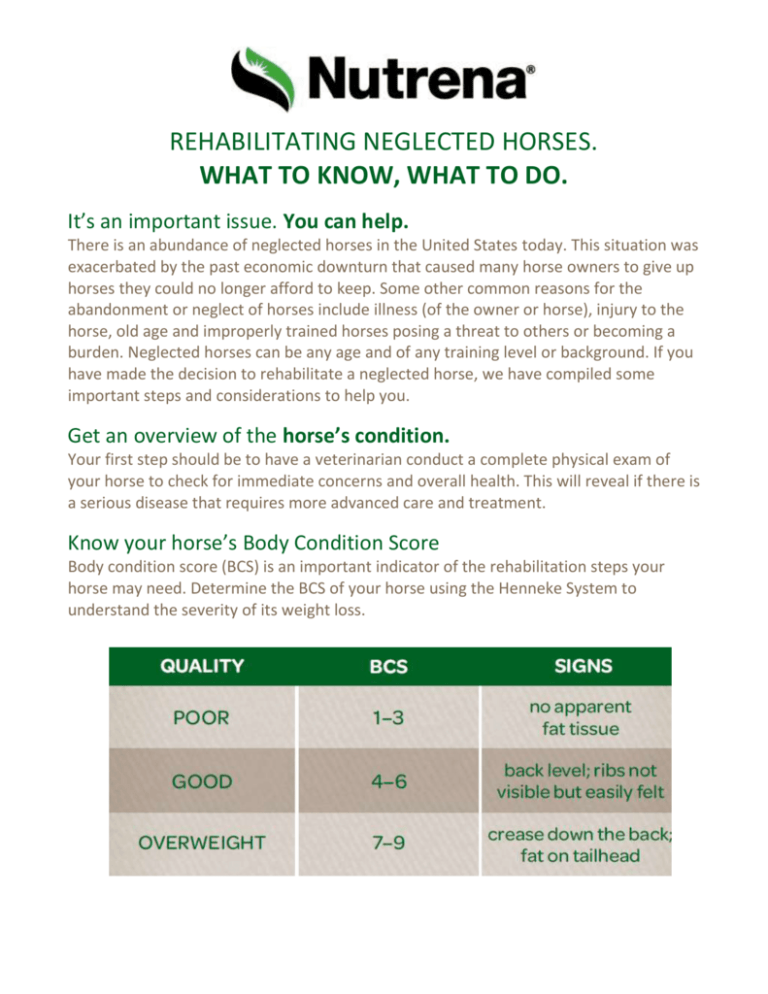
REHABILITATING NEGLECTED HORSES. WHAT TO KNOW, WHAT TO DO. It’s an important issue. You can help. There is an abundance of neglected horses in the United States today. This situation was exacerbated by the past economic downturn that caused many horse owners to give up horses they could no longer afford to keep. Some other common reasons for the abandonment or neglect of horses include illness (of the owner or horse), injury to the horse, old age and improperly trained horses posing a threat to others or becoming a burden. Neglected horses can be any age and of any training level or background. If you have made the decision to rehabilitate a neglected horse, we have compiled some important steps and considerations to help you. Get an overview of the horse’s condition. Your first step should be to have a veterinarian conduct a complete physical exam of your horse to check for immediate concerns and overall health. This will reveal if there is a serious disease that requires more advanced care and treatment. Know your horse’s Body Condition Score Body condition score (BCS) is an important indicator of the rehabilitation steps your horse may need. Determine the BCS of your horse using the Henneke System to understand the severity of its weight loss. Determining Body Condition Score. The ideal BCS for most horses is 5. A BCS of 4 to 6 is good — the back is level and the ribs are not visible but can be easily felt. The shoulders and neck should blend smoothly into the body. General BCS definitions list 1 as Poor (emaciated with no fat and with bony structure visible) to 3 as Thin (limited fat with some skeletal structure visible). A BCS of 7 to 9 is considered overweight, with a crease down the back being present. It is difficult to feel the horse’s ribs and there is soft fat around the tailhead. The neck and inner buttocks will be thicker, and there is bulging fat over the ribs, tailhead, withers, shoulders and neck. Weighing your horse without a scale. Using an equine weight tape, measure in inches your horse’s heart girth. Measure across the highest part of the withers and keep the tape as close behind the elbows as possible. Next, using two people, measure in inches your horse’s body length from the point of the shoulder, straight back along the horse’s side, to the point of the buttock or crease. Depending on your horse’s age, use one of the following equations to estimate weight. Adult horse: (Heart Girth x Heart Girth x Body Length)÷ 330 = Bodyweight in pounds Yearling: (Heart Girth x Heart Girth x Body Length)÷ 301 = Bodyweight in pounds Weanling: (Heart Girth x Heart Girth x Body Length)÷ 280 = Bodyweight in pounds The right diet can make a big difference. Malnourished horses Horses with a BCS of 3 or higher can normally be brought to the target BCS of 5 in about six to eight weeks. These horses should be fed a balanced diet at 1.5% of their bodyweight in four or five feedings per day. A balanced diet would constitute 50% good quality hay and 50% concentrate feed. The amount of feed can be gradually increased to 2.5–2.8% of bodyweight with hay offered free choice and grain being fed two or three times a day (with a maximum 0.5% bodyweight per feeding). Complete feeds, such as Nutrena® SafeChoice® Senior, are well-suited to feed neglected horses due to their controlled starch, high digestibility and easy-to-chew attributes. Additionally, neglected horses are often salt-starved. Therefore, salt should be introduced gradually at one to two ounces per day and increased until it can be given free choice. At all times, fresh, clean water should be available. 14% 16% PROTEIN FIBER 8% FAT The right diet can make a big difference. Starved horses Horses with a BCS of 1 or 2 have often experienced actual starvation. These situations typically happen over 60 to 90 days without feed or more often three to four months with very poor water and forage. Horses in these situations are often hypoglycemic and hyperkalemic due to muscle mass and fat loss. If the horse is able to get up and has lost less than 45–50 % of its bodyweight, it can normally be rehabilitated. If it has lost 45– 50% of its bodyweight and is not able to get up, be aware that the chances of successful rehabilitation may be reduced significantly. Alfalfa hay option Quality alfalfa hay is a good base for a high protein, low starch diet. Frequent, small amounts of quality alfalfa hay should be fed, with the amount of alfalfa slowly increasing for each meal. The number of feedings should decrease gradually over 10 days, and after 10 to 14 days, the horse can be given free-choice feeding. If the horse’s dental condition is poor, alfalfa cubes or pellets may be used and soaked prior to feeding. Senior Horse Feed Option Senior horse feeds with a controlled starch design, added amino acids, prebiotics, probiotics, balanced trace minerals and vitamins are the best option to give a neglected horse the nutrients it needs. The feed should be introduced at a rate of 0.5% bodyweight in several small feedings per day. Over a 10- to 14-day period, the amount of feed should slowly increase per meal while the number of feedings gradually decreases. By the end of this period, the horse should be at a normal feeding rate according to feeding directions. The feed can also be soaked in warm water for up to 15 minutes to form a mash for horses with poor teeth. A twist of fate for Oliver Twist. “I met Oliver Twist at a rescue facility. He looked like he was 38 years old, but he’s only 6. He looked like a walking skeleton … his body was shutting down, he lost bladder control, the ability to feel pain or flies biting him, and they told me they believed there was a possibility that his brain and organs may have been affected by the malnutrition. I fed him SafeChoice® twice daily for eight days. I adopted Oliver, and he’s mine now. He is extremely intelligent, very loving and affectionate. It’s only been three-and-ahalf months, but I can’t believe his transformation. Thank you so much for providing such a wonderful product. I believe it saved Oliver’s life. Oliver thanks you too!” — Kristel Laporte, Indiana Additional necessary care to aid recovery. Deworming Working with your veterinarian, once your horse has enough weight and body condition to be dewormed, a larvicidal treatment controlling strongyles, roundworms and pinworms may be used. After four weeks, ivermectin or moxidectin may be administered. Your veterinarian should also create a parasite control program (often this will utilize tools such as fecal egg counts to optimize dewormers). If your veterinarian suspects heavy parasite infestation, particularly with roundworms in young horses, a reduced dose may be considered for the first deworming. This can reduce the risk of intestinal blockage. Vaccinations Frequently, the medical history of neglected horses is unknown, and previous deworming information and vaccination records are unavailable. Working with your veterinarian, your horse can be vaccinated for endemic diseases in your geographic area. There are five core vaccines (from the American Association of Equine Practitioners) that will most likely be administered: Tetanus, West Nile Virus, Eastern and Western Equine Encephalomyelitis and Rabies. The vaccines should be spread over several days to avoid overwhelming the horse’s system, especially in neglected horses, as most often have a heavy parasite burden and compromised immune system. It is also normal for neglected horses to receive primary doses (two doses spread several weeks apart) of the vaccines as an added precaution. Hoof Care Normally, hoof care involves farrier visits every four to eight weeks, but for a neglected horse unique issues can require special measures with shorter schedules. It is imperative that you work closely with a credible farrier, especially to address the special needs of neglected horses with little previous care. Radiographs of all hooves may be needed to detect any internal damage and to create a plan to address angles and trims. Note that neglected horses must have enough weight to stand for farrier care (readiness can be determined by your farrier). Neglected horses will need a long-term program for hoof care. Since the hoof capsule regenerates, a healthy hoof can be grown in less than a year if proper nutrition and veterinary care are provided. Additional information and resources. With the abundance of neglected horses today, it has become important for those wishing to aid these horses to have a good understanding of the special needs and steps to rehabilitate these magnificent animals. With the proper nutrition, veterinary attention and caretaking, you can give a neglected horse a second chance at a healthy, productive life. Nutrena® Website NutrenaWorld.com AAEP Website aaep.org Nutrena® Horse Blog HorseFeedBlog.com Knowledge Center http://www.NutrenaWorld.com/nutrena/knowledge-center/horse/index.jsp



